kentos
Menu principale:
ceramisti
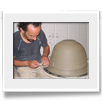
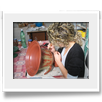
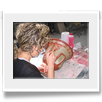
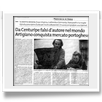
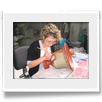
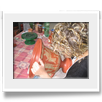
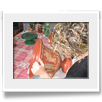
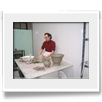
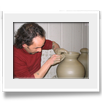
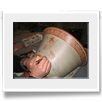
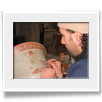
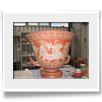
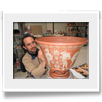
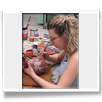
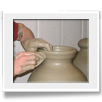
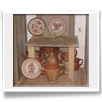
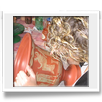
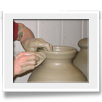
Il vasaio Stancanelli del 2005 d.C.
Rosario Patané
Sul lato principale di un cratere a figure rosse, Thanatos e Hypnos (Morte e Sonno) trasportano il corpo esanime di Sarpedonte sul campo di battaglia di Troia. Vi è un uso abbondante della linea in rilievo per definire i contorni delle figure; mentre si usa la gamma di toni della vernice diluita per i muscoli e per tutta una serie di dettagli. La vernice nera del fondo, su cui si stagliano le figure e le fasce di palmette, è lucida, regolare, compatta. Sotto il piede del vaso si legge la firma di chi lo ha realizzato al tornio e poi lo ha dipinto: "epoiesen egraphsen Salvatore Stancanelli"; una sede insolita per la firma di un vasaio e/o di un ceramografo attici. E infatti non si tratta del cratere realizzato nel Ceramico di Atene da Euxitheos e decorato da Euphronios, alla fine del VI secolo a.C., e oggi esposto al Metropolitan Museum di New York. Il cratere, leggermente più piccolo dell'originale, è stato realizzato nel 2005 d.C. in un laboratorio di Centuripe, in cui si ricreano oggi imitazioni di oggetti archeologici. Naturalmente per realizzare al tornio un vaso di quel tipo, e soprattutto per dipingerlo alla maniera di Eufronio, ci vuole bravura. Tanta. Il procedimento è un po' il segreto di Pulcinella: tutti i manuali di ceramografia spiegano che la cosiddetta vernice nera attica si otteneva applicando argilla liquida, che poi in cottura diventava prima rossa (per un fenomeno di ossidazione) e poi nera (per un fenomeno di riduzione). Questo, almeno, nelle linee generali. Riuscire a farlo realmente è un'altra cosa. I materiali, comunque, sono prodotti naturali. Semplice argilla. Ma, che argilla? E qui l'artigiano/artista ribatte: "Provi a chiedere la formula della Coca Cola". Il cratere "come quello di Eufronio" è coperto da un panno rosso: l'autore dice che vedendolo si distrae dal lavoro. Su un tavolo vicino sono degli oggetti in lavorazione: anche cosine commerciali, ma sempre fatte con buona mano. Laboratori di questo tipo a Centuripe ce ne sono diversi. Esistono ovviamente le diverse specializzazioni. D'altra parte, è inutile dire che non tutti sono allo stesso livello; il fenomeno è di moda e ci si buttano in tanti. Qualcuno è un fornitore dei negozi di musei come il Louvre. Una buona copia di un quadro non ha certo lo stesso effetto di una riproduzione fotografica (e neanche lo stesso prezzo); allo stesso modo, avere per casa riproduzioni di oggetti archeologici è cosa molto diversa sia dal procurarsi in maniera illecita i corrispondenti autentici, sia dal farsi bidonare acquistando un falso per vero. In Italia, una legge stabilisce le regole da usare per le copie di opere d'arte e le imitazioni di oggetti archeologici: le truffe sono un'altra cosa. In ogni caso, forse è meglio esibire in salotto l'imitazione di un'opera famosa, notoriamente esposta in un museo: così si sgombra subito il campo da equivoci e si attira di più l'attenzione sulla qualità dell'esecuzione. Sulla qualità ovviamente non si transige: se no, vuol dire che non si è in grado di vedere la differenza. Un'osservazione, infine su una "stranezza": gli oggetti archeologici veri, dentro le vetrine dei musei, non presentano mai incrostazioni terrose: sono state pazientemente rimosse. Le imitazioni che fanno arredamento in salotto, invece, hanno quasi sempre un po' di terra addosso, col compito di dare un aspetto non troppo nuovo.
On the main side of a red pictures crater, Thanatos e Hypnos (death and sleep) carry the Sarpedonte's body on the battlefield of Troy. There's a large use in relief lines for edge of characters; range tones of diluted paint for muscles and all other details. The backgroung black paint, is lucid, regular, compact. Below the vase foot there's the sign of the artist how built at the wheel and drew it:"epoiesen egraphsen Salvatore Stancanelli"; it's an unsual place for the sign. We aren't talking about the crater done in the Athen's Ceramic from Euxitheos and drew by Euphronios at the end of VI century b.C., and today exhibited at the Metropolitan Museum of New York. The crater, a little bit smaller than the original, was made in the 2005 d.C. in a laboratory of Centuripe (Sicily), where the work is archeological objects reproduction. Of course for realize at the wheel a vase like this, and expecially for decorate at the Eufronio's style, need a lot of skills. The process is well know: all the ceramics tutorial books explain that attica black paint was got applying liquid clay, baking it became red at first (for oxidation) and black later (for reduction). All this in general way. It looks easy but in real work fases there's many problem to find out. The materials, anyway, are natural products. Simply clay. But, which kind of clay? At this question the craftsman/artist says:"Why don't you try to ask for the Coke recipe?". The crater "like the Eufronio's one" is covered with a red sheet: master says that just see it can't be concentrate in other works. Over a near table there are some objects still in working process: small commercial things too, but always done with good hand. In Centuripe there's some laboratories like this. Each one have a different work style. Anyway, don't need to underline that not all have the same skills; Somebody sells at Louvre museum shops. A good copy of a picture doesn't have the same effect of a photographed reproduction (neither the same price!); at the same way, having at home archeologic objects reproduction is very different to buy in illegal way a true one, or buy a fake object instead of a true one. In Italy, there's laws and rules to follow for reproduction of art works and archeological objects imitation: frauds are other things. Furthermore, maybe is better show at home the imitation of a famous art work, well know exhibited in a museum: so nobody can think that you bought something illegally and can concentrate all the attentions on the high quality of work done. At the end I want spend some words on a "strange thing": The True archeologic objects, inside the glass box of the museums, have never dry earth over: all them was patiently moved over. Imitations for home, instead, quite always have some earth on, so it don't looks too much new.
The Director of the Archeological Museum of Centuripe
Rosario Patanè